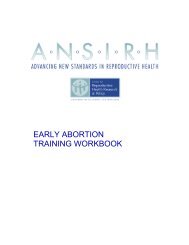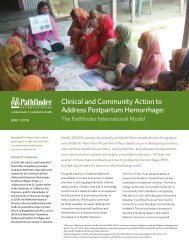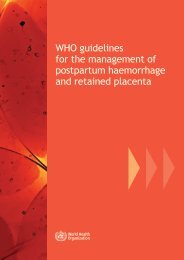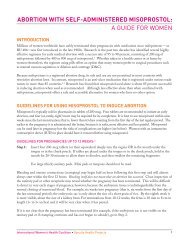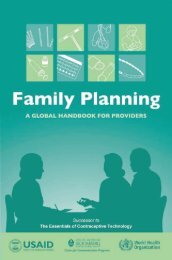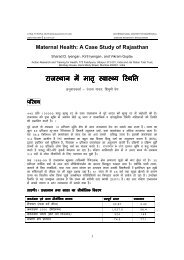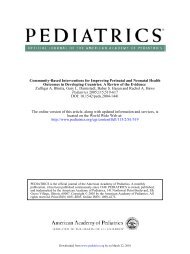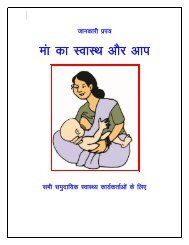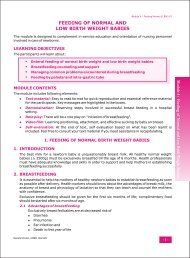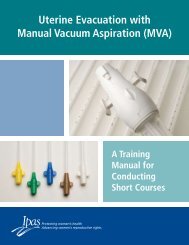Gender Gaps in Research on Abortion in India - CommonHealth
Gender Gaps in Research on Abortion in India - CommonHealth
Gender Gaps in Research on Abortion in India - CommonHealth
Create successful ePaper yourself
Turn your PDF publications into a flip-book with our unique Google optimized e-Paper software.
process with<str<strong>on</strong>g>in</str<strong>on</strong>g> the many-layered c<strong>on</strong>text of women's lives - their social, ec<strong>on</strong>omic, and gender-power<br />
situati<strong>on</strong> vis-à-vis their husband and marital families. These studies give rise to many <str<strong>on</strong>g>in</str<strong>on</strong>g>terest<str<strong>on</strong>g>in</str<strong>on</strong>g>g issues<br />
for further explorati<strong>on</strong> and analysis. What are the c<strong>on</strong>textual and gender-related factors that affect<br />
aborti<strong>on</strong> decisi<strong>on</strong>-mak<str<strong>on</strong>g>in</str<strong>on</strong>g>g? Under what circumstances is the decisi<strong>on</strong> mutual and c<strong>on</strong>sensual am<strong>on</strong>g<br />
couples? When is there discordance? What happens when there is disagreement between couples?<br />
What factors enable women to successfully negotiate with their husbands? Which women proceed to<br />
term<str<strong>on</strong>g>in</str<strong>on</strong>g>ate their pregnancy despite objecti<strong>on</strong> from their husbands, and why? What are the circumstances<br />
that make it possible for women to do so? What may be the c<strong>on</strong>sequences, (e.g. violence, refusal to<br />
support <str<strong>on</strong>g>in</str<strong>on</strong>g> case of health problems)?<br />
In order to address these questi<strong>on</strong>s, studies are needed that talk to a large enough number of both<br />
women users of aborti<strong>on</strong> as well as their husbands/partners to be able to arrive at a c<strong>on</strong>ceptual<br />
framework <strong>on</strong> factors <str<strong>on</strong>g>in</str<strong>on</strong>g>fluenc<str<strong>on</strong>g>in</str<strong>on</strong>g>g the aborti<strong>on</strong> decisi<strong>on</strong> pathway.<br />
Health seek<str<strong>on</strong>g>in</str<strong>on</strong>g>g behaviour 11<br />
Delay <str<strong>on</strong>g>in</str<strong>on</strong>g> seek<str<strong>on</strong>g>in</str<strong>on</strong>g>g aborti<strong>on</strong> services<br />
How far <str<strong>on</strong>g>in</str<strong>on</strong>g>to the pregnancy do women seek aborti<strong>on</strong> services and undergo the procedure? What are the<br />
reas<strong>on</strong>s for delay?<br />
Several studies give <str<strong>on</strong>g>in</str<strong>on</strong>g>formati<strong>on</strong> <strong>on</strong> the gestati<strong>on</strong>al period at which aborti<strong>on</strong> was f<str<strong>on</strong>g>in</str<strong>on</strong>g>ally carried out. The vast<br />
majority of aborti<strong>on</strong>s took place dur<str<strong>on</strong>g>in</str<strong>on</strong>g>g the first trimester (9,10,36, 65,70,72), but there were also a significant<br />
number of sec<strong>on</strong>d trimester aborti<strong>on</strong>s <str<strong>on</strong>g>in</str<strong>on</strong>g> some studies. In the rural Maharashtra study, 26% of aborti<strong>on</strong>s took<br />
place <str<strong>on</strong>g>in</str<strong>on</strong>g> the sec<strong>on</strong>d trimester and about 3% bey<strong>on</strong>d the legally acceptable limit of 20 weeks (10).<br />
Those who wanted to space or limit births decided fairly early, by 8 weeks, although there was a delay<br />
<str<strong>on</strong>g>in</str<strong>on</strong>g> actually avail<str<strong>on</strong>g>in</str<strong>on</strong>g>g of the services. In c<strong>on</strong>trast, those seek<str<strong>on</strong>g>in</str<strong>on</strong>g>g to abort a female child had an aborti<strong>on</strong> at<br />
a mean gestati<strong>on</strong>al period of 16.6 weeks because of the wait to have a sex-detecti<strong>on</strong> test which is d<strong>on</strong>e<br />
<str<strong>on</strong>g>in</str<strong>on</strong>g> the sec<strong>on</strong>d trimester (10).<br />
Another reas<strong>on</strong> for delay <str<strong>on</strong>g>in</str<strong>on</strong>g> avail<str<strong>on</strong>g>in</str<strong>on</strong>g>g of aborti<strong>on</strong> appears to be marital status. Unmarried women have<br />
several barriers to access<str<strong>on</strong>g>in</str<strong>on</strong>g>g aborti<strong>on</strong>, such as the stigma attached to a pregnancy out-of-wedlock, as<br />
well as public sector providers' reluctance to perform aborti<strong>on</strong>s <str<strong>on</strong>g>in</str<strong>on</strong>g> unmarried women. This can cause<br />
c<strong>on</strong>siderable delay <str<strong>on</strong>g>in</str<strong>on</strong>g> gett<str<strong>on</strong>g>in</str<strong>on</strong>g>g an aborti<strong>on</strong>. In Sevagram hospital <str<strong>on</strong>g>in</str<strong>on</strong>g> rural Maharashtra, 72.2% of <str<strong>on</strong>g>in</str<strong>on</strong>g>duced<br />
aborti<strong>on</strong>s <str<strong>on</strong>g>in</str<strong>on</strong>g> unmarried women took place <str<strong>on</strong>g>in</str<strong>on</strong>g> the sec<strong>on</strong>d trimester as compared to 42.6% am<strong>on</strong>g married<br />
women (66). A similar observati<strong>on</strong> is made also by the Chandigarh case-c<strong>on</strong>trol study compar<str<strong>on</strong>g>in</str<strong>on</strong>g>g<br />
married and unmarried aborti<strong>on</strong> users (27). In this latter study, 60% of unmarried women were sec<strong>on</strong>d<br />
trimester aborti<strong>on</strong> seekers, as compared to <strong>on</strong>ly 7% of married women.<br />
Delay may also be caused at an earlier stage - <str<strong>on</strong>g>in</str<strong>on</strong>g> recogniti<strong>on</strong> of the pregnancy by the woman. This is<br />
likely to be the case when pregnancy follows sterilisati<strong>on</strong> failure or occurs dur<str<strong>on</strong>g>in</str<strong>on</strong>g>g lactati<strong>on</strong>al<br />
amenorrhoea, when women may believe they could not possibly be pregnant. Women for whom poor<br />
nutriti<strong>on</strong> and irregular periods may be the norm may also have difficulty identify<str<strong>on</strong>g>in</str<strong>on</strong>g>g a delayed period as<br />
a potential pregnancy till symptoms such as morn<str<strong>on</strong>g>in</str<strong>on</strong>g>g sickness beg<str<strong>on</strong>g>in</str<strong>on</strong>g> to appear. However, <strong>on</strong>ly <strong>on</strong>e study<br />
(71) menti<strong>on</strong>s that women were <str<strong>on</strong>g>in</str<strong>on</strong>g>to denial of their pregnancy, and n<strong>on</strong>e of the others have exam<str<strong>on</strong>g>in</str<strong>on</strong>g>ed<br />
the c<strong>on</strong>tributi<strong>on</strong> of this 'first delay' to the delay <str<strong>on</strong>g>in</str<strong>on</strong>g> the overall process of seek<str<strong>on</strong>g>in</str<strong>on</strong>g>g aborti<strong>on</strong> services.<br />
Choice of service providers<br />
11.The follow<str<strong>on</strong>g>in</str<strong>on</strong>g>g studies fall under this secti<strong>on</strong>: Reference numbers 9, 10, 13, 17, 27, 30, 36, 50, 55, 59, 65, 66, 70, 71, 72, 76.<br />
11



